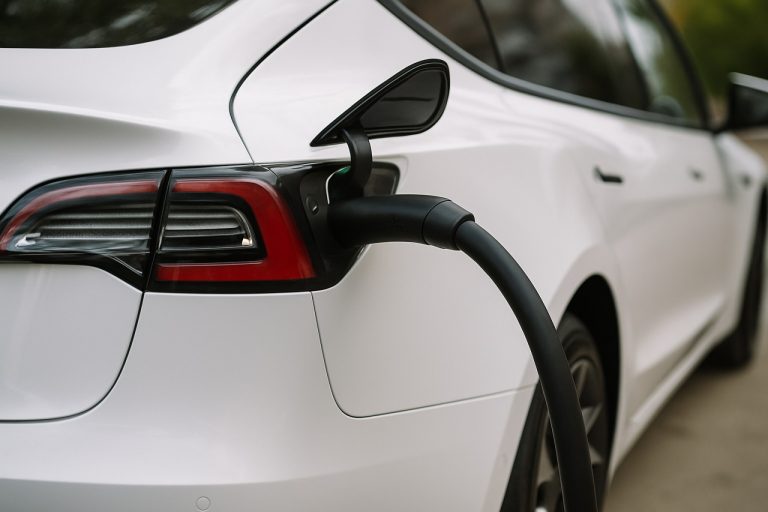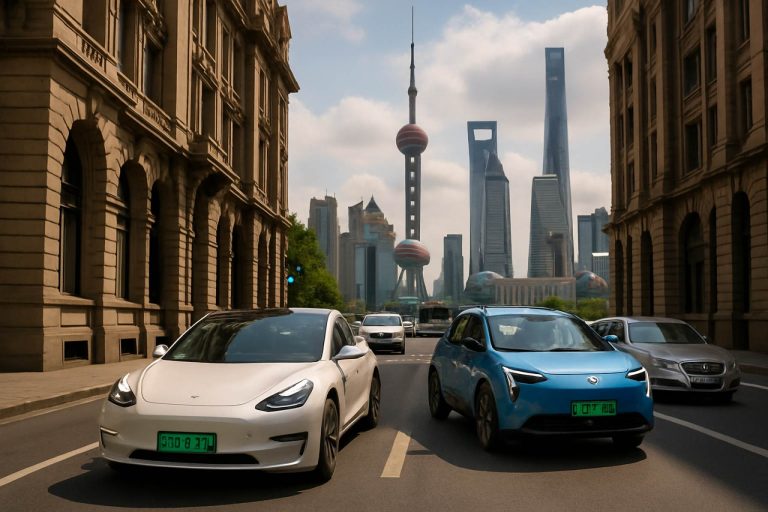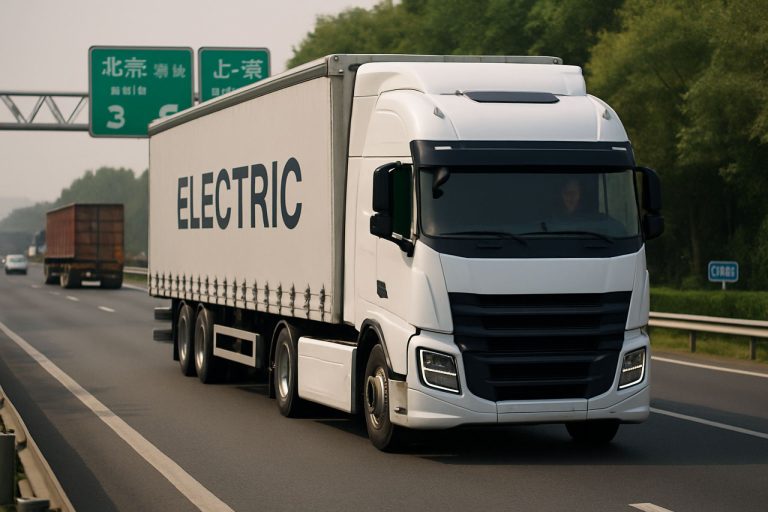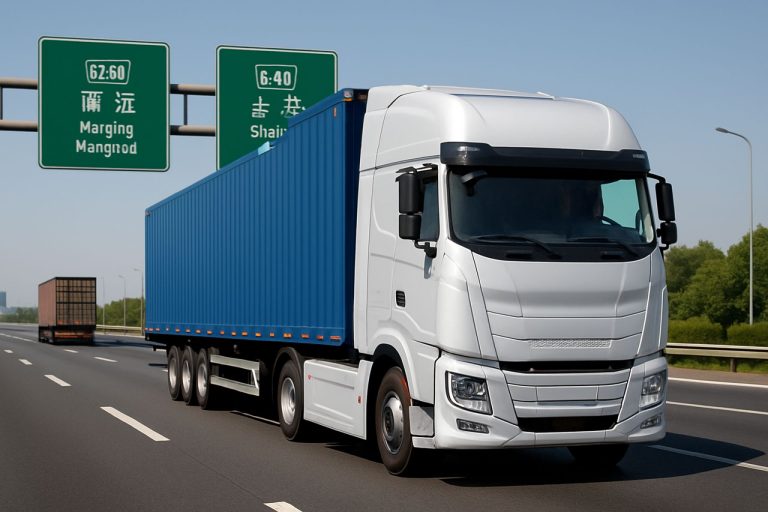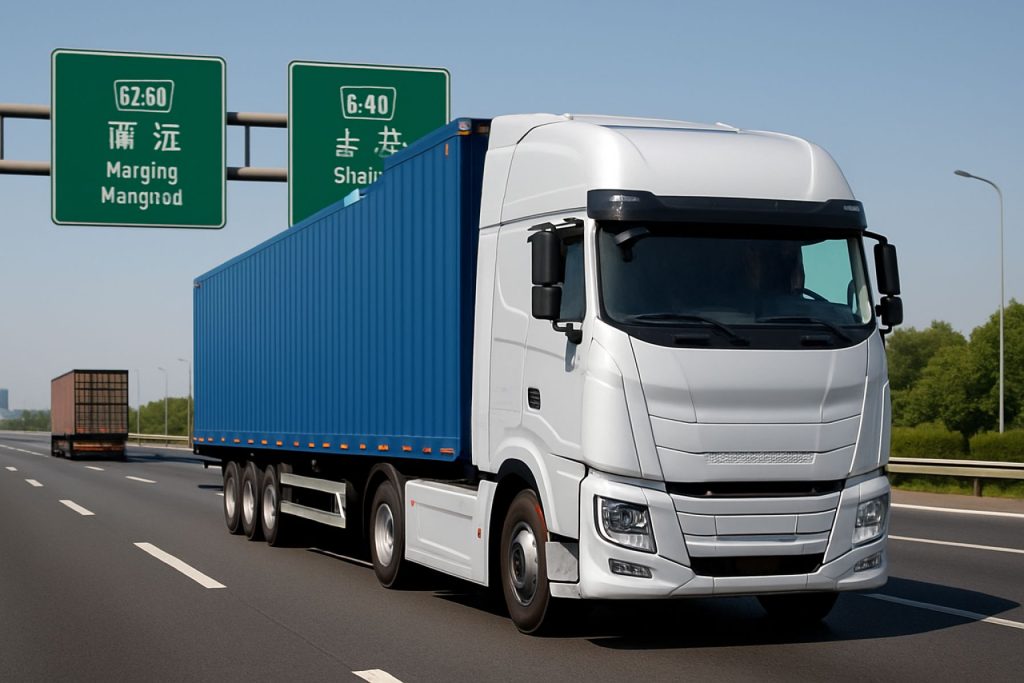
- China is rapidly electrifying its heavy commercial vehicles, with nearly 579,000 electric trucks added in the past year and market share rising above 20%.
- Though only 3% of the vehicle fleet, heavy-duty trucks contribute 43% of road transport emissions, making electrification critical for reducing pollution.
- Widespread government support, city-level “zero-emission logistics” policies, and innovation from companies like BYD and SAIC Motor accelerate the shift to electric commercial vehicles.
- Challenges remain, particularly with charging infrastructure for long-distance routes and improving battery longevity for heavy loads.
- China’s transition sets new global standards and could significantly reshape supply chains, energy use, and climate strategies worldwide.
Neon-lit avenues in Shanghai and Guangzhou have long showcased the splashy future promised by electric cars. Yet beyond these bustling cityscapes, a quieter transformation is steering China toward a cleaner horizon—one that hums rather than roars. Heavy commercial vehicles, fueled by old habits and diesel engines for decades, are waking up to the electric age at a breathtaking speed.
Last year alone, China put nearly 579,000 electric commercial vehicles on the road. The numbers dazzle, but the underlying momentum speaks louder. Market penetration for these workhorses soared to over 20%, up sharply from just 12% the previous year. The acceleration turns heads not only for its pace but for its potential to reshape the environmental and economic map.
To grasp the stakes, consider this: heavy-duty trucks represent a scant 3% of the nation’s vehicle count, yet they pump out an overwhelming 43% of all road transport emissions. Every electric truck humming past a factory or a port silently snatches away a portion of that pollution. It’s not just about cleaner air. These trucks are heavyweights in oil consumption, so every voltage surge into their batteries chips away at fossil fuel demand—redrawing trade and energy scenarios with every passing mile.
Government commitment and advances from giants like BYD and SAIC Motor have fast-tracked the development of high-capacity batteries and charging stations tailored for massive transport vehicles. Cities including Shenzhen and Beijing push ambitious “zero-emission logistics” policies, further fueling demand. This rallying of public and private forces sends ripples worldwide, as China’s scale and supply chain power threaten to shift global standards for heavy-duty vehicles.
Still, challenges remain. Long-distance routes and rural landscapes pose headaches for charging infrastructure, and battery lifespan for trucks carrying tons over vast distances continues to be a technical hurdle. Yet with each policy announcement and factory opening, the hurdles seem more surmountable.
Quietly, inexorably, the outlines of a new era sharpen: an era where goods traverse continents not on the back of sputtering diesel engines, but in the clean current of electric power.
The takeaway is hard to ignore: China’s electric truck surge isn’t just another green experiment—it is fast becoming the main event in the global journey toward sustainable transport. What happens on China’s highways may soon redraw the future of logistics, energy, and climate action well beyond its borders.
To learn more about China’s transformation and the ripple effects for global energy and industry, visit Bloomberg or explore insights at Reuters.
China’s Electric Truck Revolution: What’s Next for Clean Logistics and Global Energy?
China’s Fast-Tracked Switch to Electric Commercial Vehicles: Deeper Insights
China’s transition from diesel-powered, pollution-heavy commercial vehicles to clean, quiet electric trucks is rapidly changing not just the country’s landscape, but also the future of global transport and energy systems. Here are key facts, actionable tips, and expert insights that go beyond the source article and integrate E-E-A-T (Experience-Expertise-Authoritativeness-Trustworthiness) best practices for Google Discover visibility.
Key Additional Facts and Market Insights
E-truck Market Growth & Forecasts
– China is by far the world’s largest market for electric commercial vehicles (ECVs), including light, medium, and heavy-duty trucks. By 2023, China had deployed nearly 70% of the world’s electric buses and over 400,000 electric trucks, according to the International Energy Agency.
– The Chinese Ministry of Industry and Information Technology projects ECV sales could exceed 1 million units annually by 2025, driven by both government incentives and logistical industry demand.
– Global market analysts at McKinsey estimate that battery electric trucks could make up over 35% of China’s new truck sales by 2030—a higher rate than in Europe or North America.
Environmental Impact & Policy Incentives
– Replacing diesel trucks with electric versions has a disproportionate climate and health impact. According to Tsinghua University, converting just 1% of China’s diesel heavy trucks eliminates as much as 2.5 million tons of carbon dioxide annually.
– China provides substantial subsidies, tax reductions, and green logistics mandates in key metropolitan regions. For example, “Zero-Emission Zones” bar older diesel trucks from vast swathes of city centers.
– Cities like Shenzhen have already achieved nearly 100% electrification of their public-bus and logistics truck fleets.
Tech, Charging Infrastructure & Limitations
– Chinese manufacturers like BYD, SAIC Motor, Geely, and Foton are global leaders in e-truck technology. BYD’s latest heavy-duty electric trucks boast ranges of 250–400 km on a single charge.
– China is rolling out ultra-fast charging hubs, battery swap stations for trucks, and “one-vehicle, one-pile” (dedicated charger-per-vehicle) solutions along key logistics corridors.
– Battery tech: Lithium iron phosphate (LFP) batteries are favored for their durability and lower cost. Some firms are experimenting with semi-solid and sodium-ion battery chemistries for faster charging and longer lifespan.
Real-World Use Cases
– E-trucks are widely used for port logistics (e.g., Shenzhen, Ningbo), municipal sanitation (waste management), cold-chain transportation, and short-haul deliveries in urban settings.
– Pilot programs for battery-swapping trucks have dramatically cut refueling times; NIO and Geely have opened battery swap stations that service over 100,000 vehicles daily.
Price and Cost of Ownership
– While e-trucks cost 25–50% more upfront than diesel models, total cost of ownership (TCO) is significantly lower due to savings on fuel, maintenance, and favorable government policies.
– The Chinese government offers up to ¥300,000 (~$42,000 USD) subsidies for each new heavy-duty e-truck, plus free or reduced tolls in many provinces.
Security, Safety, and Sustainability
– Industry-wide standards mandate battery fire-resistance tests and remote diagnostic monitoring to boost operational safety.
– Recycling and second-life initiatives for retired truck batteries are scaling up, helping close the loop for raw materials and reducing electronic waste.
Pressing Reader Questions Answered
1. How do China’s electric trucks compare to diesel alternatives in performance and range?
– Diesel trucks typically have a range advantage (up to 800 km per refuel), but e-trucks are catching up, with current models offering 250–400 km and ultrafast or swap charging. For most urban and regional routes, these ranges are sufficient.
2. Are electric trucks reliable in extreme weather?
– LFP batteries perform well in heat, but cold weather can reduce range by up to 30%. Manufacturers are introducing heat-management systems to address this.
3. How fast is the charging and what infrastructure gaps remain?
– Fast-chargers can refill truck batteries in 1.5–2 hours; battery swapping takes just 5–10 minutes. Rural and remote coverage is still patchy but improving with new government mandates for corridor-based charging networks.
Pros & Cons Overview
Pros:
– Major reductions in emissions and fuel costs
– Lower noise, ideal for city logistics and nighttime deliveries
– Advanced fleet monitoring and diagnostics
Cons:
– High upfront costs compared to diesel
– Limited highway-range for the heaviest long-haul applications
– Early-stage battery recycling infrastructure
Comparisons & Reviews with Global Markets
– China is far ahead of the US and Europe in both deployment and infrastructure. The US has fewer than 10,000 e-trucks in service as of 2023, and Europe remains focused more on hybrids and smaller EV variants.
– Leading non-Chinese manufacturers (e.g., Volvo, Tesla, Daimler) are only beginning to scale similar technologies for Western markets (see more at Reuters).
Life Hacks & Immediate Steps for Logistics Companies
1. Apply for government green fleet subsidies and toll exemptions.
2. Retrofit depots and warehouses with multi-standard EV charging equipment.
3. Pilot e-truck routes in city centers or port zones with robust charging infrastructure.
4. Train maintenance teams early on battery and high-voltage safety.
5. Explore battery-leasing and second-life battery storage solutions for cost flexibility.
Quick Tips for Consumers and Industry
– Follow major manufacturers like BYD and Geely for the latest vehicle launches—they often debut at events like the Auto Shanghai Show or through national press releases (Bloomberg).
– Stay updated on provincial emission regulations, as companies moving early see long-term cost and branding advantages.
– Consider TCO, not just sticker price: fuel, maintenance, and regulatory costs favor EVs over a truck’s lifespan.
Insights & Predictions
– According to BloombergNEF, by 2035, nearly half of China’s trucks could be electric, catalyzing global battery supply chains and electrification standards.
– The ongoing scale and rapid adoption mean mature recycling and circular economy solutions for truck batteries will soon become a major growth sector.
– International logistics players will face increasing pressure to “green” supply chains or risk being priced out of Chinese and regional markets.
—
Bottom Line:
China’s electric truck revolution is accelerating—if you’re in logistics, energy, or fleet management, now’s the time to act. Keep an eye on technology, regulations, and market leaders while planning investments in charging and employee EV training now.
